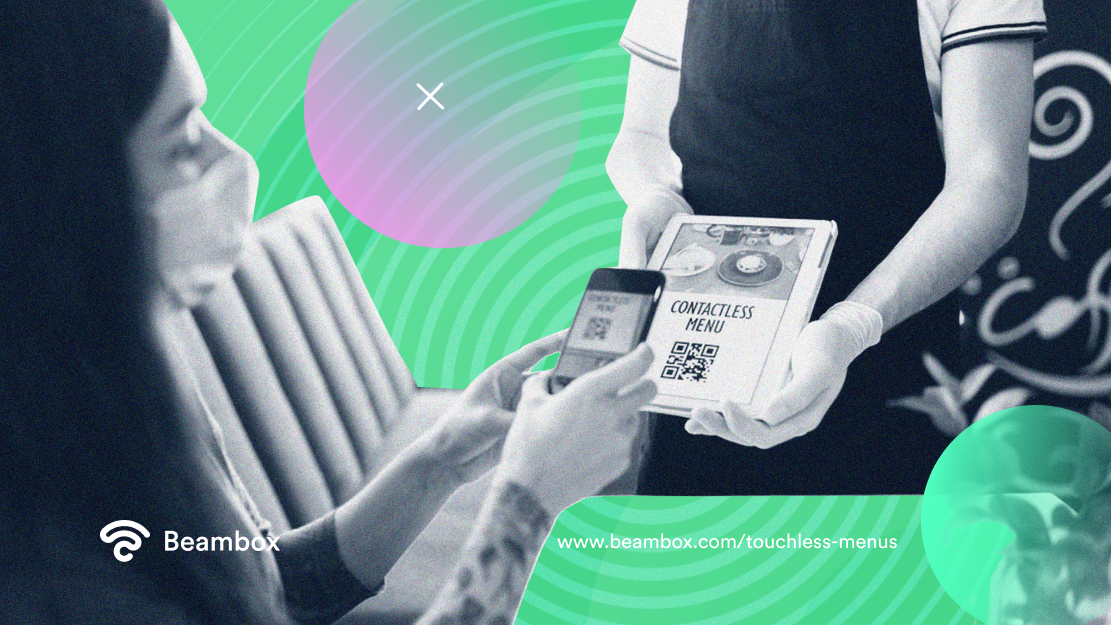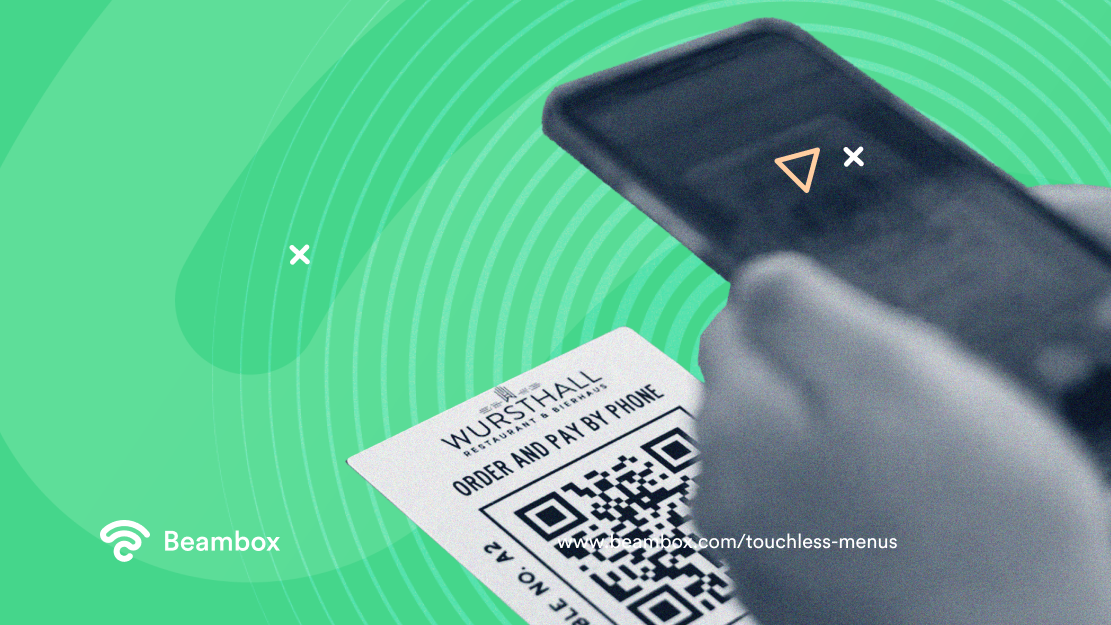You’ve likely seen touchless menus before, also known as contactless menus. They appeared all over restaurant and café tables as different locations adapted to lockdown restrictions over the last few years. Yet, while governments have lifted restrictions in most places, touchless and contactless menus are still widely used.
Why are restaurants still using touchless menus, and why should you do the same? Let’s get into it.

First of all, how do touchless menus work, and how do customers use them?
Touchless menus are digital menus that customers can access using their phones or other mobile devices. This removes the need for physical menus passed around from table to table. It allows customers to look at the food and drink options immediately, on their own personal device, rather than waiting on a server to drop by first.
Customers access them most frequently using quick response codes, or QR codes, that are placed around the restaurant, most frequently on the tables themselves. QR codes work similarly to barcodes in that users simply scan them with their smartphones. It immediately brings up the webpage or PDF file you’ve embedded into the code.
Implementing this type of menu using near-field communication (NFC) chips is also possible. Restaurant owners can embed NFC chips into signs or other fixtures, and customers need only hold up their smartphones near the signs to use them. The chip triggers a web page that appears on the screen. To use this technology, restaurant owners must invest in a smart sign and connect it to the digital menu they want customers to see.
Touch screen menus are interactive digital screens you would see most frequently in fast-casual restaurants. They differ from touchless menus because users cannot access them from their phones, and multiple people use the screen at different times to order.
Touch screen menus are less popular in the types of restaurants that use paper or physical menus. That’s because there are typically a limited number of screens around the restaurant that diners can use. Diners must wait their turn to use them, which is part of what makes them more appropriate for fast-casual restaurants.
Touchless menus allow diners to access the menus themselves from their tables.

Now that you’ve got a clearer idea of what touchless menus are and how they work, let’s look at their benefits. Here are six reasons why you might want to use a contactless menu instead of a physical one.
As we mentioned above, QR code menus boomed in the midst of the pandemic, and that is because touchless menus are a safer, more sanitary option than permanent menus.
Restaurants that use physical menus only print a limited amount for customers to reuse. A menu at an establishment that serves breakfast, lunch, and dinner passes through dozens of people’s hands. This increases the spread of germs, and it can make diners as well as the wait staff sick.
In some cases, servers take the time to wipe down menus after each table has finished with them, but not all restaurants do this. And for those that do require servers to wipe down menus, this takes up valuable time for the restaurant staff.
With contactless menus, customers peruse the restaurant’s offerings using their personal devices, and no physical menus get passed from hand to hand. It keeps the restaurant staff safe, and it keeps customers safe.
At the height of the Covid-19 lockdowns, restaurant owners were looking for the most ideal ways to limit contact with their customers, so many turned to disposable paper menus instead of touchless menus. In this case, diners would enter the establishment, grab a menu, and throw it away at the end of their stay.
It is more sanitary than passing around a permanent menu, but it leads to quite a bit of waste. A typical family restaurant could serve hundreds of people in a day if each of those diners uses and disposes of a paper menu, which adds to a lot of wasted paper!
Electronic menus for restaurants eliminate the need for disposable menus while remaining sanitary.
There are plenty of pain points for customers that add friction to their dining experience when they use physical menus.
For instance, they have to wait for the servers to bring them the menu after they’ve been seated, which delays their food’s arrival. The offerings on the physical menu may be outdated, and servers have to inform the customers that certain items are no longer available after the customer has already chosen them. Also, physical menus can, of course, be stained or damaged from previous use.
Touchless menus remove all these pain points and make the customer experience as smooth as possible. Diners do not have to wait for a server to bring them a menu, and restaurants can update the offerings in real time as to what is available. And, of course, they are never stained or damaged from previous use.
Finally, the printing costs of permanent or disposable menus can be a big issue for business owners.
If a restaurant uses disposable menus, they will have to continuously print new menus to keep up with the ones thrown away. Plus, even restaurants with permanent reusable menus must reprint every time the menu changes, in addition to lamination or binding costs.
Many restaurants already have a website, including the full menu. With a QR code, all the restaurant owners will need to spend is the one-time cost of printing and posting the code. There are plenty of free options to generate the QR code itself. They then have to link the code to their existing website, and the menu is up and running.
Disabled diners can have a hard time with physical menus. The font may not accommodate visual impairments, or it may be difficult for people with limited hand mobility to pick it up.
Touchless menus are more user-friendly, allowing users to zoom in if they need to see bigger text or use screen readers to hear what is available to eat and drink.
It is even helpful for able-bodied users to use this kind of menu. They can scroll quickly through food categories, use drop-down menus, or click on hyperlinks to access nutritional information.
Physical menus must be thrown out and reprinted every time the restaurant wants to update the menu. Alternatively, servers would have to cross out and write new menu items on the page, which is not visually appealing and can be hard to read. In short, it’s a bad user experience.
With a QR code or NFC menu, business owners need only update their website or upload a new PDF file, and the touchless menu will be up to date.
In addition to keeping the menu updated, restaurant owners can also optimize their menus in impossible ways with physical menus. For example, you can add hyperlinks to the names of dishes and drinks that give users full nutritional and allergen information. You can also add menu icons and pictures, drop-down lists, and other navigational tools that allow diners to skip straight to the exact type of food or drink they’re craving. You can even ensure the digital version fits your curated restaurant theme.

With a better understanding of touchless menus and their benefits, let’s dive into how to implement a contactless menu in your restaurant, coffee shop, or other establishment.
Here’s how you do it:
- Make or update your online menu: Update your website to include a full menu version. Ideally, include photos of the food, price lists, and food allergy information. You could also make a PDF file version of your menu to link to the QR code, but a PDF is less customizable and user-friendly than an HTML version. Also, a high-quality website is an excellent asset to have, either way, to draw people in before they’ve even stepped through the restaurant doors.
- Hook up your guests with free WiFi: Equip your restaurant with fast, accessible, and free guest WiFi. Without a proper WiFi connection, users won’t be able to access the QR code and connect to the digital menu.
- Generate a QR code: Use a QR code generator to create a QR code and link it to the web page with your menu on it. There are many free QR code generators online, so take a look and pick the one that works best for your needs. You test it a few times on different devices to ensure it works.
- Post the QR code: Print out the generated QR code and post it in easily accessible places around the establishment: on the tables, beside the cash registers, etc. Laminating them is a good idea so they don’t wear and tear with time.
And voilà! You are now ready to optimize the diner experience with safer, easier touchless menus.
Of course, as we mentioned in step two above, your guests won’t be able to access the menu if they cannot get online. Some diners can rely on their data networks to see the menu. However, many people have limited data usage or prefer connecting to WiFi for a better user experience.
Suppose you want to set up a guest WiFi network that enhances the customer experience while offering you insights into their behavior, interest, and footfall analytics. In that case, we recommend trying out Beambox. It’s the best guest WiFi solution for high speeds, smarter targeting, and increased customer loyalty. You can even give it a try for 30 days for free. Learn more and start growing your business right away.
Get Started With Free WiFi Marketing
Beambox helps businesses like yours grow with data capture, marketing automation and reputation management.
Sign up for 30 days free